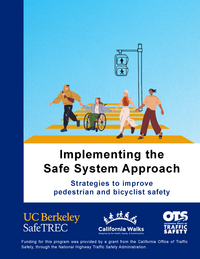Comunidades Activas y Seguras (Active and Safe Communities) is a joint program of UC Berkeley SafeTREC (SafeTREC) and California Walks (Cal Walks). After working with communities of diverse backgrounds through our statewide Community Pedestrian and Bicycle Safety Training program, we decided to create a curriculum tailored to better meet the needs of Spanish-speaking communities. Since its inception in 2021, Comunidades Activas y Seguras (CAyS) has been dedicated to enhancing walking and biking safety through a community-centered approach. We prioritize cultural and linguistic sensitivity to effectively identify and address walking and biking safety concerns. Our team works with a local Planning Committee to customize the workshop to ensure that it meets the unique needs of the community.
CAyS collaborates with communities to:
-
Improve safety for pedestrians and bicyclists in Spanish-speaking communities in California;
-
Engage communities in active transportation safety discussions and be a part of decision-making processes;
-
Connect community members and stakeholders within participating communities to each other and create opportunities for collaboration;
-
Partner with stakeholders working on issues adjacent to transportation safety, e.g: environmental justice, housing, food security; and
-
Create shareable educational content for social media and other virtual outlets.
2025 Comunidades Activas y Seguras trainings
This year, the CAyS program will partner with up to four communities throughout California with large monolingual Spanish-speaking populations to discuss, plan, and implement active transportation safety improvements. Applications are now closed. This year, we will work with the following communities:
| Site | County | Workshop Date |
|---|---|---|
| Ashland/Cherryland | Alameda | Wednesday, May 28, 2025 |
| Tranquillity | Fresno | Wednesday, June 11, 2025 |
| Paramount | Los Angeles | Monday, July 14, 2025 |
This year, we will be providing follow-up support to two former CAyS sites in California to support their community’s implementation of programs, projects, and recommendations outlined in their community action plan. We will partner with these communities in two overarching areas: strengthening data-driven narratives and community leadership and capacity strengthening.
If you would like more information about the CAyS program or follow-up support, or have questions, please contact us at safetrec@berkeley.edu
Our past work
As of 2025, SafeTREC and Cal Walks have conducted 142 pedestrian and bicycle safety trainings throughout California, including 13 CAyS trainings. Explore our interactive map of the CPBSP Program to view summary reports where available of each CAyS workshop, including ideas identified during the process and recommendations for pedestrian/bicycle safety projects, policies, and programs.







